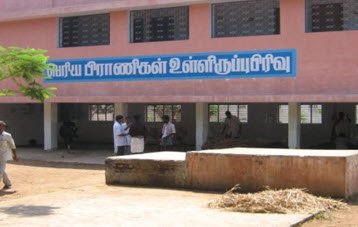Genesis
The Veterinary College Teaching Hospital, Namakkal which was erstwhile functioning as a Veterinary Hospital, under the Directorate of Animal Husbandry, Government of Tamil Nadu was taken over by the Veterinary College and Research Institute, Namakkal to impart training to the Veterinary Graduates of this Institution in the year 1989. Realizing the need to provide better and effective service to the livestock and pets of this region and to give hands on training to the Veterinary Graduates and field veterinarians, a separate Department of Clinics was established in the year 1994. As per the revised veterinary council of India syllabus, the name of the veterinary hospital has been changed as Teaching Veterinary Clinical Complex (TVCC) from 2012. This Department of Clinics presently functioning in Veterinary Hospital Campus at Trichy Road has specialized units viz., Small Animal Medicine, Small Animal Surgery, Small animal Gynaecology, Large Animal Surgery, Artificial Insemination, Large Animal Gynaecology and Large Animal Obstetrics for effective teaching and to bestow better service to the public and rural farmers.
Buildings
Gradually permanent structures were built to accommodate Clinical laboratory, Casualty unit, Large animal inpatient unit with owners rest room, Small animal Operation theatre with modern facilities, Referral clinics for small and large animals, Students lecture hall equipped with audio visual aids, De-torsion pit for the correction of uterine torsion in cattle and buffaloes, Deep bore well with over head tank with the capacity of 20,000 liters to provide perennial water supply and Large animal operation theatre with shadow less lamps & hydraulic operation table.
Obstetrics and Gynaecology Unit
- Common cases in farm animals treated in this unit are dystocia, uterine torsion, uterine prolapse, endometritis, metritis, under developed genitalia, repeat breeders, retained fetal membranes etc.
- This is a known referral unit for more than 12 districts for obstetrical cases like dystocia, uterine torsion and prolapse of genital organs.
- De-torsion pit available in this unit routinely utilized for relieving the uterine torsion by Schaffer's method.
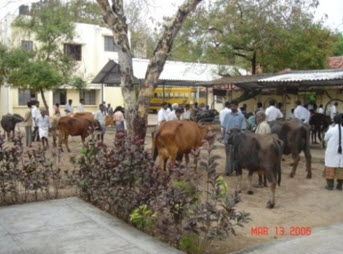
Large Animal Out-patient Unit - OG
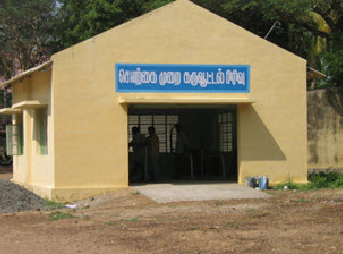
AI Unit
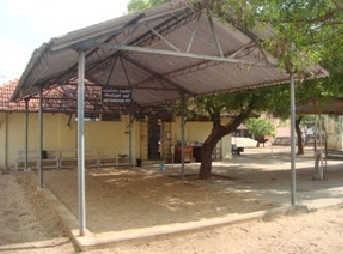
Detorsion Pit
Surgery Unit
- Common cases in farm animals treated at this unit are ruminal impaction, traumatic pericarditis, traumatic reticuloperitonitis, abomasal impaction, diaphragmatic hernia, intussusception, caecal dilatation, squamous cell carcinoma of eye and horn, equine castration, fractures and congenital disorders etc.
- This unit is having a separate large animal operation theatre with air conditioned facility was established in the year 2005.
- Various abdominal surgeries in farm ans pet animals are now being carried out with isoflurane gaseous anaesthesia and thoracic surgeries with ventilator.
- Well equipped small animal operation is available for pet animal surgeries.
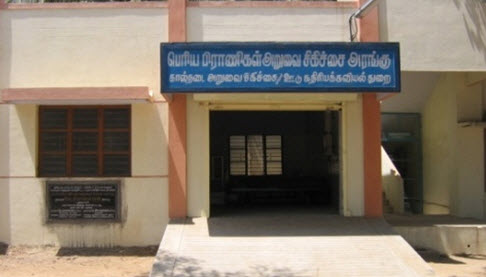
Large Animal Operation Theatre
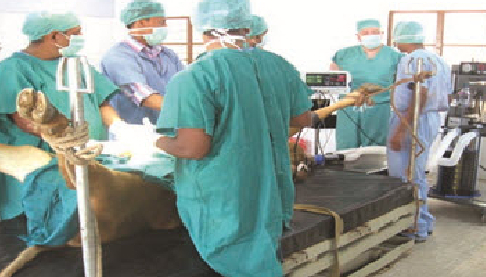
Inside view of large animal operation theatre with hydraulic operation table
Clinical Medicine Unit
- Common cases treated in Medicine units are Simple Indigestion, Vagal Indigestion, TRP, Traumatic pericarditis, Ruminal acidosis, Broncho pneumonia, Mastitis, Ruminal impaction, Urea Poisoning, Enteritis, Joint ill, Theileriosis, FMD, Anaplasmosis, Abomasal ulcers, Downer cow syndrome, etc
Referral Unit
- The Veterinary College Hospital of Veterinary College and Research Institute, Namakkal, Tamil Nadu serves as the regional referral centre for more than 18 districts of the state for large and small animal clinical sciences in this region and the reputation was built up on the untiring committed work of the dedicated staff.
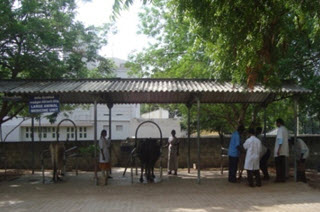
Large animal Out-patient Unit - Medicine
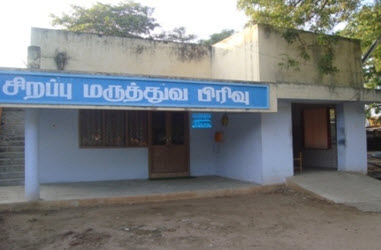
Referral Unit
In-patient unit with owners' rest room
Large animal Inpatient owner's rest room is functioning in this hospital since 2000. On an average of 10-12 inpatient cases are being maintained per day. The in-patient animal owners are being provided with rest room which is a unique facility available in this hospital.
Equipments
- Ultra sound facility is available in the Obstetrics and gynaecology unit for diagnosing early pregnancy, various infertility problems in small and large animals and to study follicular dynamics in bovines.
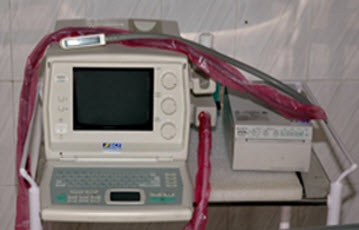
Transrectal /Transabdominal Ultrasound
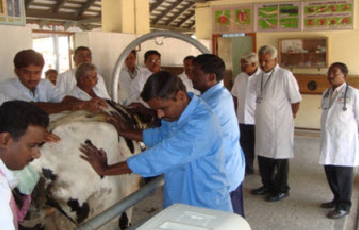
Pregnancy diagnosis with Transrectal Ultrasound
- Various estrus synchronization procedures like Co-Synch, Ov-Sych, Pre-Synch, Heat-Synch were standardized and routinely followed to augment fertility in rural bovines.
- Evaluation of breeding bulls for breeding soundness with SC test and rear leg conformation etc was standardized.
- The Obstetrics and gynaecology unit is not only handling U.G. and P.G. Education but also provides clinical training to overseas students from U.S.A (Michigan state university, Virginia state) and Bangladesh.
- Accurate estrus detection with estrus detector and timed AI were standardized and followed in this hospital.
- The surgery unit standardized the diagnosis and surgical management for Intussusception, caecal dilatation, abomasal impaction and displacement and diaphragmatic hernia in cattle and buffaloes. Further gaseous anaesthetic protocols were standardized for various farm animal surgeries with isoflurane.
- A separate radiology building approved by BABA Atomic Research Institute was established for the first time in India at a cost of Rs.12 lakhs. It comprises of Reception, Radiologist room, 500 mAs stationary X ray machine, X ray library and air conditioned dark room and all x ray accessories.
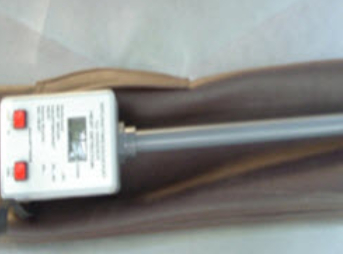
Oestrus Detector
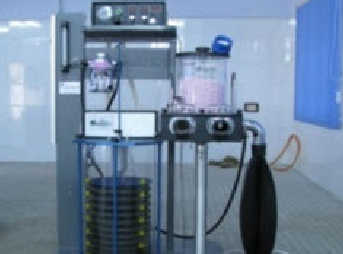
Large animal gaseous anaesthetic machine with ventilator
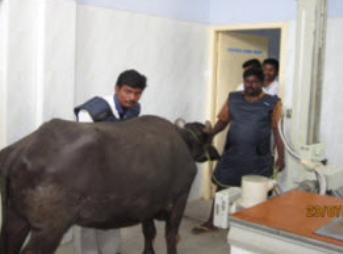
Radiology Unit
- Established referral unit with Electrocardiography, Defibrillator, Ultrasound, Colour flow Doppler and Endoscope facilities for large animals
- Doppler ultrasound facility is available for diagnosing pericarditis and other cardiac ailments in small and large animals.
- Abdominal ultrasonographic techniques for diagnosing reticular and hepatic diseases were standardized and routinely followed.
- Electrocardiography with base apex lead system is standardized and routinely followed to diagnose various cardiac ailments in large and small animals.
- Tracheobronchoscoppic techniques for diagnosing respiratory diseases in large animals were standardized and followed.
- Standardized oesophagoscopic technique in diagnose and relieve choke in bovines.
- Equipped mastitis lab to diagnose sub-clinical mastitis is available in this hospital.
- The collapsible chute is utilized to restrain the animals for the clinical examination and application of special diagnostic techniques viz., endoscopy and Ultrasonography
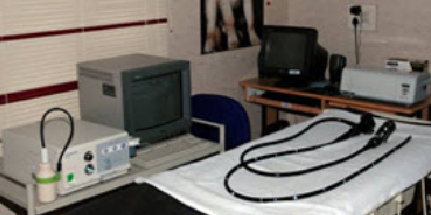
Endoscopy
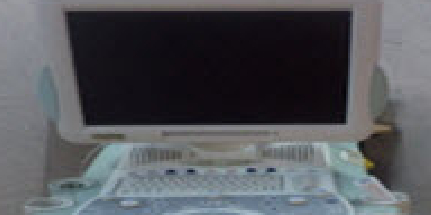
Diagnostic Ultrasound
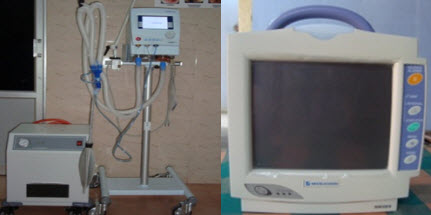
Critical Care Ventilator and Vital Signs monitor in the ECC unit
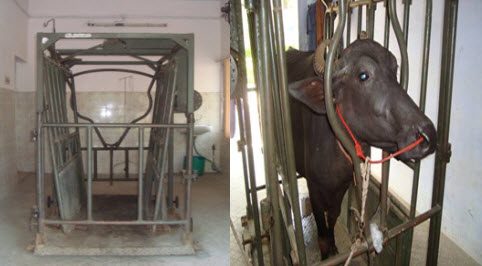
Chutes for Clinical Examination
- 12 lead ECG is used to diagnose changes in the heart rate and rhythm. The accuracy is more than the conventional ECG
- Weighing balance for large animals is used to weigh the body weight of the large animals upto 1000 kg. It is a unique facility present in this hospital, so that UG students can know the actual weight of the animal for calculating the dose of drugs and also they can compare the formula derived weight with actual in each animal.
- Ultrasound dental scaler is highly useful for removing the dental tartar and plaques in pet animals
- Hind quarter elevator is useful to handle obstetrical cases, cervico-vaginal prolapse, uterine prolapse etc.
Cases Treated
On an average 40 to 50 cattle and buffaloes, small ruminants and around 30-40 small animals are being treated in this hospital every day. In Large animals around 10 major surgeries and 15 minor surgeries are performed per month. Around 15 major surgeries and 20 minor surgeries in small animals are done every month. An average of 12-15 artificial inseminations is done per day. Obstetrical emergencies especially dystocia, uterine torsion and Prolapse of the uterus and cervix are attended to at all hours. To cater the needs of the rural mass, a 24 hour casualty service is started from 2010. A few wild animals like Malabar squirrel, Scaly Ant eater and Indian Rock Python, Spotted deer and Barking deer belonging to the forest department have been successfully treated here. A few temple elephants were also referred to this hospital and were successfully treated for various ailments.
| Year |
Clinical Cases Treated |
Total |
AI done |
Revenue Generated (Rs.) |
| Bovine |
Cannine |
Sheep & Goats |
Horse |
Others |
Cow |
Buffalo |
Goat |
| 2012-13 |
8714 |
9929 |
2579 |
252 |
370 |
21622 |
1484 |
826 |
89 |
9,83,905 |
| 2013-14 |
7627 |
11702 |
3739 |
366 |
284 |
23696 |
1109 |
512 |
64 |
11,46,450 |
| 2014-15 |
9952 |
14509 |
178 |
389 |
239 |
29549 |
1323 |
633 |
110 |
15,14,859 |
| 2015-16 |
7477 |
11362 |
166 |
175 |
11 |
22995 |
1789 |
531 |
104 |
16,60,384 |
| 2016-17 |
6526 |
7791 |
767 |
166 |
203 |
17736 |
893 |
588 |
69 |
16,79,152 |
Faculty
- Dr. S.Dharmaceelan | Professor and Head | Veterinary Surgery and Radiology
- Dr. S.Monoharan | Assistant Professor | Veterinary Gynaecology and Obstetrics
- Dr. G.Senthilkumar | Assistant Professor | Veterinary Clinical Medicine
- Dr. P.Vikramachakravarthy | Assistant Professor | Veterinary Pharmacology and Toxicology
- Dr. P. Sankar | Assistant Professor | Veterinary Surgery and Radiology







